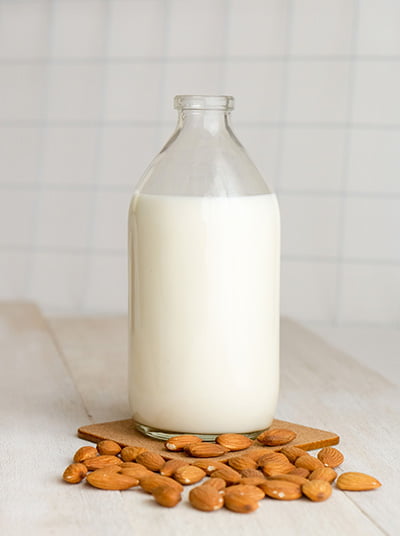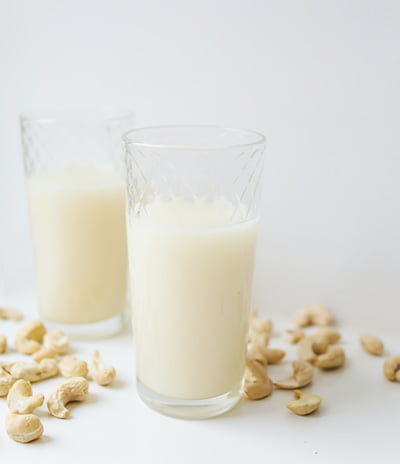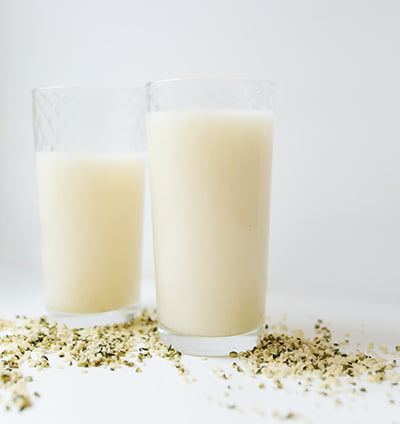Nut milk has become a staple in households' refrigerators, replacing traditional dairy milk for those seeking non-dairy or vegan-friendly alternatives. Making homemade nut milk is incredibly simple and convenient, as you likely have all the necessary ingredients in your pantry. The best part of making nut milk at home is that you have full control over the customization of your nut milk, knowing exactly what goes into it. In contrast, store-bought nut milk often contains fillers for a creamy texture, fortified vitamins for product appeal, artificial flavors for taste enhancement, and preservatives. These factors make a strong case for the benefits of making your own nut milk at home.
Making nut milk at home is more cost effective and offers a healthier and incredibly delicious option compared to store-bought nut milk. The versatility of homemade nut milk extends to the types of nuts you can use, such as almonds, cashews, hazelnuts, or even a blend of them. Additionally, if you want to stay away from nut milk, you can explore nut-free alternatives using oats or seeds. When it comes to crafting your own distinctive blends and flavors, the potential for homemade nut milks is limitless.
Below, I will guide you through how to make nut milk in the comfort of your home and what essential ingredients and equipment you will need to make your own nut milk.
What you need to make nut milk
Making homemade nut milk is a straightforward process, but it does require a few essential ingredients and equipment. Here's what you'll need to make nut milk at home:
Ingredients
Nuts: Choose your preferred nuts, such as almonds, cashews, hazelnuts, or any other variety. For a distinct flavor experience, you have the option to experiment with a medley of nuts.
Water: For optimal taste and quality, it is recommended to utilize filtered water.
Sweeteners (Optional): If you prefer slightly sweetened nut milk, you can add natural sweeteners like dates, maple syrup, honey, or agave syrup. Tailor the quantity based on your personal taste preferences.
Flavorings (Optional): You can enhance the flavor of your nut milk by adding vanilla extract, cinnamon, cardamom, or any other desired flavorings.
Salt (Optional): A pinch of salt can help balance the flavors and enhance the overall taste of your nut milk.
Equipment
Blender: A high-speed blender is recommended to thoroughly blend the nuts and water, as strong power can chop nuts into smooth, creamy nut milk.
Nut Milk Bag or Cheesecloth: They serve the purpose of straining the blended mixture, effectively separating the milk from the nut pulp. Nut milk bags are specifically designed for this purpose and can be easily found online or in kitchenware stores, and cheesecloth is a more widely available alternative.
Opt for unbleached options when shopping for a nut milk bag or cheesecloth. An unbleached nut milk bag is free from chemical bleaching agents commonly used to produce bleached fabrics, and this ensures that no harmful substances are leaching into your nut milk during the straining process. Unbleached nut milk bags also do not leave behind any residual taste or odor on the strained milk.
Bowl or pitcher: Use a bowl or pitcher to collect the strained nut milk.
Different Nuts And Seeds Milk Taste
Almond Milk

Homemade almond milk recipe is simple, and making almond milk is a rewarding process. The flavor profile of homemade almond milk is delicately sweet with a mild essence and a gentle hint of nuttiness. Almond milk has a clean and refreshing taste in its pure form, offering a delicate and creamy texture lighter than cow's milk. Some people describe the flavor as nutty and pleasantly smooth. The inherent sweetness of almonds imparts a delightful touch of natural sweetness to the nut milk.
Cashew Milk

Cashew milk has a creamy and slightly sweet flavor that differs from almond milk. Homemade cashew milk has a creamy and slightly sweet flavor that is distinctively different from almond milk. Because it has a neutral flavor profile, cashew milk makes a great base for incorporating other flavors.
One of the key characteristics of cashew milk is its creaminess. Cashews release their natural oils when blended, creating a smooth and rich texture. This creaminess makes cashew milk a popular choice for adding richness to recipes or as a base for creamy beverages like lattes or smoothies.
Hazelnut Milk
Hazelnuts have a unique and robust flavor that imparts a distinct nuttiness to homemade hazelnut milk. The taste is often described as rich, earthy, and slightly sweet. Hazelnuts lend a natural depth to the milk, providing a delightful and satisfying flavor experience.
Unlike some of the other types of nuts, hazelnuts possess a distinct aroma that is also present in homemade hazelnut milk. The aroma adds to the sensory experience, enhancing the overall enjoyment of the homemade nut milk.
Walnut Milk
Walnuts have a robust and distinct nutty flavor, which carries over to homemade walnut milk. The taste is often described as earthy, deep, and aromatic. The natural flavor of walnuts gives the nut milk a rich and satisfying nuttiness.
Walnuts have a slightly bitter taste compared to other nuts, and this bitterness can be more pronounced in homemade walnut milk, especially if the walnuts are not soaked prior to blending. Soaking the walnuts can effectively diminish bitterness and achieve a more subdued flavor profile.
Like hazelnut, walnuts have a unique aroma that is also present in homemade walnut milk. The aroma enhances the overall sensory experience, introducing depth and richness to the homemade nut milk.
Pecan Milk
Pecans are known for their buttery and nutty flavor, and these characteristics carry over to homemade pecan milk. The taste is often described as rich, smooth, and indulgent. Pecan milk offers a unique and delightful flavor that sets it apart from other nut milks.
Pecans naturally have a subtle sweetness that contributes to the overall taste of homemade pecan milk. While the sweetness is not overpowering, it adds a pleasant and delicate touch to the nut milk. The mild sweetness complements the nuttiness, creating a well-balanced flavor profile.
Pistachio Milk
Pistachios have a rich and distinctive nutty flavor that carries over to homemade pistachio milk. The taste is often described as earthy, buttery, and mildly sweet. The natural flavor of pistachios gives the milk a distinct and enjoyable nuttiness.
Pistachios have a natural sweetness that adds a pleasant touch to homemade pistachio milk. While not as pronounced as some other nut milks, the subtle sweetness of pistachios contributes to the overall taste and enhances the nut milk's flavor profile.
Brazil Nuts Milk
Brazil nuts have a mild and delicate flavor that translates to homemade Brazil nut milk. The taste is often described as smooth, creamy, and subtly sweet. The natural creaminess of Brazil nuts lends a luxurious texture to the nut milk.
While Brazil nuts have a nutty flavor, it is more subdued than other nuts like almonds or walnuts. The nuttiness in homemade Brazil nut milk is gentle and not as assertive, allowing for a balanced and enjoyable taste.
Macadamia Nuts Milk
Macadamia nuts are known for their high-fat content, contributing to homemade macadamia milk's creamy and velvety texture. The taste is often described as indulgent, buttery, and smooth, and Macadamia milk offers a luxurious and satisfying flavor experience.
Macadamia nuts have a natural, subtle sweetness that adds a pleasant touch to homemade macadamia milk. The sweetness is not overpowering but provides a delicate and well-balanced flavor profile. It enhances the overall taste and makes macadamia milk enjoyable to drink on its own or in various recipes.
Oat Milk
Oat milk has a mild and neutral flavor compared to nut-based or plant-based milk. It doesn't have a strong taste that overpowers other flavors, making it versatile for various culinary uses. Oat milk allows the flavors of other ingredients in recipes to shine through.
Oats naturally contain a small amount of natural sugars, contributing to a mild sweetness in homemade oat milk. The sweetness is balanced and pleasing, complementing the overall taste. If desired, you can customize the sweetness by incorporating natural sweeteners such as dates, maple syrup, or honey, based on your preference.
Hemp Milk

Hemp milk boasts a unique nutty and earthy flavor that distinguishes it from other non-dairy milk alternatives. The taste is often described as mildly grassy or reminiscent of a blend between sunflower seeds and walnuts, and the nuttiness gives hemp milk a character of its own.
Hemp milk may have a slight graininess due to the nature of hemp seeds, and this texture is more noticeable in homemade versions than in store-bought varieties. However, you can minimize the graininess by thoroughly blending the hemp seeds and straining the milk.
Coconut Milk

Coconut milk is known for its indulgent and creamy taste. When made at home, it retains the natural richness and full-bodied flavor of coconuts. The taste is often described as velvety, luscious, and tropical.
The flavor of homemade coconut milk is characterized by its unmistakable coconut essence. It offers a pronounced coconut taste that is fragrant, aromatic, and reminiscent of the tropics. The flavor is commonly characterized as rich, nutty, and delicately sweet.
Pumpkin Seeds Milk
Pumpkin seed milk offers a unique and pleasant nutty flavor. The taste is often described as mildly earthy, with hints of roasted seeds. It is not as intense as some other nut or seed milks but provides a distinct and enjoyable flavor profile.
Pumpkin seed milk may have subtle savory undertones, which adds depth to its flavor. These undertones give the milk a unique and more complex taste than other plant-based milk.

How To Make Nut Milk
Step 1: Soak The Nut(S)/ Seeds
Commence the process by soaking your preferred nuts or seeds in water. This soaking method effectively softens the nuts, facilitating easier blending. The soaking time varies but typically ranges from 4 to 8 hours or overnight. Soaking nuts overnight may just be the easiest way but refer to specific recipes for the recommended soaking time for your chosen nuts.
Step 2: Drain Nuts and Rinse
After soaking, drain the nuts and rinse them thoroughly to remove any residual soaking water.
Step 3: Blend the nuts and water

Transfer the soaked and rinsed nuts into a blender. Add fresh water at a ratio of approximately 3 to 4 cups of water per 1 cup of nuts. Adjust the water amount based on your desired consistency, more water for thinner homemade nut milk and less water for creamier homemade nut milk.
At this point, you can also have the option to add any sugar, salt, flavoring, or spices to elevate your homemade nut milk.
Blend the mixture on high speed until the nuts are completely broken down, and the mixture becomes smooth and creamy. Blending duration relies on the potency of your blender and the desired texture you wish to achieve.
Step 4: Strain the milk
Place a nut milk bag, cheesecloth, or fine-mesh sieve over a bowl or pitcher. Carefully pour the blended mixture into a nut bag or cheesecloth, enabling the liquid to strain through while retaining the pulp. Gently squeeze or press the nut milk bag or sieve to extract as much nut milk as possible.
Step 5: Store and refrigerate
The homemade nut milk recipe does not contain preservatives or additives, so that it can last in the refrigerator for 3-4 days. Prior to each use, remember to give it a good shake as natural separation may occur.
How To Store Your Nut Milk
Store the homemade nut milk in sealed containers and place it in the refrigerator for up to 4 days. You can save the leftover nut pulp for other uses, and don't throw it away! Incorporating it into your baked goods is an excellent way to utilize it.
How To Make Nut Milk FAQs
How long does homemade nut milk last?
When stored in a sealed container in the refrigerator, homemade nut milk typically maintains freshness for approximately 3 to 4 days. However, before consuming, it's always best to check for any signs of spoilage, such as an off smell or taste.
Do I need to strain the nut milk?
Straining the nut milk is generally recommended to achieve a smoother and pulp-free consistency. Straining helps separate the milk from any remaining solid particles. However, you can skip the straining step if you prefer thicker and more fiber-rich nut milk.
Can I use the leftover pulp from straining nut milk?
Yes, the leftover pulp from straining nut milk can be utilized in various ways. You can incorporate it into various recipes such as baked goods, smoothies, and granola. Additionally, it can be used as a delightful topping for oatmeal or yogurt. You can also dehydrate the pulp to make a nut meal or incorporate it into veggie burgers or energy bars.
What can I do with leftover nut milk pulp?
Leftover nut milk pulp can be used in various recipes. It can be added to baked goods, used as a thickening agent in soups or sauces, or incorporated into energy balls or homemade granola bars. Unleash your creativity and embark on a journey of experimentation with various recipes to fully utilize the potential of the pulp.
Which type of nuts should I use: raw or roasted?
It is generally recommended to use raw nuts when making homemade nut milk. Raw nuts provide a neutral base flavor and allow for a smoother blending process. Roasted nuts may alter the taste and result in darker-colored homemade nut milk. However, if you prefer a more pronounced nutty flavor, you can experiment with making nut milk using lightly roasted nuts, keeping in mind that it might affect the overall taste and texture of the nut milk.
Tips For How To Make Nut Milk Creamy
Avoid over-blending: While blending is necessary to achieve a smooth consistency, be mindful not to over-blend, as it can cause the homemade nut milk to become frothy or develop a slimy texture.
Use a high-speed blender: A powerful blender can effectively break down the nuts, resulting in creamier nut milk. Blending for a longer duration may also help achieve a smoother consistency.
Adjust the water-to-nut ratio: Experiment with the amount of water used in the recipe to achieve your desired thickness and creaminess. Using less water can yield a creamier nut milk while adding more water creates a lighter consistency.
Blend with additional ingredients: Adding ingredients like dates, coconut oil, or coconut cream to the blending process can contribute to a creamier texture and richer flavor.
Chill the milk before using: Refrigerating the freshly made homemade nut milk can enhance its creaminess. Before consuming, it is recommended to let the milk cool in the refrigerator for a few hours.
